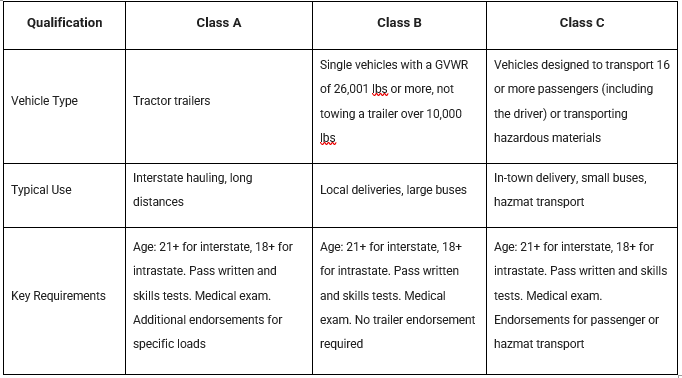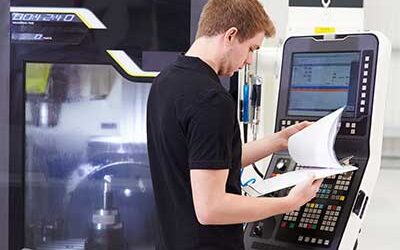Meet the Unsung Heroes of the Highway
Every day, thousands of Commercial Driver’s License (CDL) holders take to the roads, driving the economy forward one delivery at a time. These drivers are the backbone of the logistics and supply chain industry, ensuring that everything from fresh produce to medical supplies reaches its destination safely and on time. The importance of CDL drivers cannot be overstated—they are crucial to maintaining the flow of goods across cities, states, and even countries.
Becoming a CDL driver is no small feat. It requires a combination of specialized training, adherence to strict regulations, and a commitment to safety. Drivers must navigate through a variety of challenges, from long hours on the road to the meticulous planning required for each trip. Yet, the role of a CDL driver offers a unique sense of freedom and responsibility. It’s a career path that opens up opportunities to see new places, meet different people, and have a tangible impact on the daily lives of millions.
This introduction sets the stage for a closer look at what CDL drivers do, the types of driving jobs available, and the skills necessary to succeed in this vital field. As we delve into the lives of these road warriors, we’ll uncover the challenges they face, the rewards they reap, and the future of driving in an ever-evolving industry.
Commercial Drivers – The Backbone of Transportation
Entering through the world of commercial driving starts with understanding the cornerstone of the profession: the Commercial Driver’s License (CDL). This license is more than just a permit to drive large and heavy vehicles; it’s a career gateway for those looking to make their mark in the transportation industry. The journey to obtaining a CDL is multifaceted, involving rigorous training, examinations, and a deep commitment to road safety.
The CDL universe is categorized into three main classes: Class A, B, and C. Each class is tailored to specific vehicle types and driving purposes. For instance, a Class A license enables drivers to operate tractor-trailers, the behemoths that dominate highways and carry the bulk of cross-country freight. Class B is designed for drivers operating straight trucks, large passenger buses, and segmented buses. Lastly, Class C licenses are for those intending to drive vehicles transporting hazardous materials or more than 16 passengers.
 The process of obtaining a CDL is methodical and thorough, ensuring that all drivers are equipped with the necessary skills and knowledge to safely maneuver large vehicles on public roads. Prospective drivers must first pass a series of written exams to demonstrate their understanding of road safety, vehicle maintenance, and transportation regulations. Following the written tests, a practical driving exam assesses the applicant’s ability to handle a commercial vehicle in various situations, from highway driving to tight urban environments.
The process of obtaining a CDL is methodical and thorough, ensuring that all drivers are equipped with the necessary skills and knowledge to safely maneuver large vehicles on public roads. Prospective drivers must first pass a series of written exams to demonstrate their understanding of road safety, vehicle maintenance, and transportation regulations. Following the written tests, a practical driving exam assesses the applicant’s ability to handle a commercial vehicle in various situations, from highway driving to tight urban environments.
Training for a CDL is not just about mastering vehicle operation. It also encompasses learning the intricate details of federal and state regulations, log keeping, and the ethical responsibilities of being a professional driver. Many opt for formal training programs, which range from intensive courses at specialized schools to community college classes, to prepare for the exams and gain hands-on experience.
Beyond the basics, special endorsements can be added to a CDL, allowing drivers to transport hazardous materials, tow double or triple trailers, and operate tank vehicles. These endorsements further diversify a driver’s qualifications and open up additional career paths within the industry.
Comparing CDL Classes: A Guide to Qualifications

A Day in the Life of a Commercial Driver
The life of a Commercial Driver’s License (CDL) holder is one of routine, responsibility, and the open road. Each day begins before sunrise for many, with a thorough pre-trip inspection of their vehicle. This isn’t just a cursory glance over the truck; it’s a detailed check of the brakes, tires, lights, and more to ensure everything is in top working condition. Safety is paramount, and this ritual underscores its importance in the daily life of a driver.
Once on the road, the CDL driver becomes the captain of their ship. Navigating through bustling city streets or cruising on long stretches of highway requires constant vigilance and an intimate knowledge of the vehicle. The cargo they carry, whether it be perishable goods, construction materials, or consumer products, is their responsibility. Loading and unloading these goods efficiently and safely is a skill honed over time, often involving equipment like forklifts or manual lifting aids.
Communication is another crucial aspect of a CDL driver’s day. Staying in touch with dispatch ensures they’re on the best route and can adjust to any changes or challenges that arise, such as weather conditions or traffic congestion. This ongoing dialogue keeps the wheels of logistics turning smoothly.
Documentation is the unsung hero of the transportation world. Accurate logs of hours worked, miles driven, and rest periods taken are not just a regulatory requirement; they’re essential for the safety and well-being of the driver. Electronic logging devices have made this task easier, but it still requires attention to detail and honesty.
The diversity of CDL driving jobs means no two days are exactly the same. Drivers specializing in hazardous materials transport, for example, face additional regulations and responsibilities. Those in long-haul trucking spend days or weeks on the road, their cab serving as both office and home. Short-haul and local drivers, meanwhile, might return to their own beds each night, but face the challenge of navigating urban environments and tight delivery schedules.
The day ends as it began, with a post-trip inspection of the vehicle to identify any issues that need addressing before the next journey. For many CDL drivers, the satisfaction of a job well done comes not just from the paycheck, but from knowing they’ve played a vital role in keeping the country moving. Whether delivering food, fuel, or furniture, CDL drivers are the lifeblood of the economy, and their day-to-day dedication ensures that our world keeps turning.

Commercial Driver Career Paths
The road for CDL drivers isn’t just paved with long stretches of highway; it’s also lined with a variety of career paths, each offering its own unique set of challenges and rewards. Whether one dreams of the freedom of the open road or prefers the predictability of local routes, there’s a place in the CDL universe for every type of driver.
Long-haul and short-haul driving represent two primary divisions within the CDL landscape. Long-haul drivers, often referred to as over-the-road (OTR) drivers, embark on journeys that can span thousands of miles and several days. These drivers experience the vastness of the country’s landscapes, from the sun-kissed coasts to the mountainous backdrops, making their living room a constantly changing tapestry of America’s scenic beauty. The allure of long-haul driving often lies in the adventure and the independence it offers, but it demands a lifestyle that can handle weeks away from home and the solitude of the road.
On the other end of the spectrum, short-haul or local drivers operate within a more confined geographical area, typically returning home at the end of each day. This type of driving suits those who prefer a consistent schedule and the comfort of being close to home, offering a balance between work and personal life that long-haul driving can’t match. Local driving jobs might involve delivering goods to businesses and consumers or transporting materials for construction projects, keeping drivers within a familiar territory but on a tight schedule.
Specialized driving roles add another layer of diversity to CDL careers. These positions, such as hauling hazardous materials, operating tankers, or driving refrigerated trucks, require additional certifications but come with the reward of higher pay and the satisfaction of handling critical tasks. Drivers in these roles become masters of their niche, with deep knowledge of safety protocols and regulations specific to their cargo.
Each industry that CDL drivers serve—be it retail, manufacturing, or construction—brings its own set of requirements and benefits. Drivers may find themselves delivering essential supplies to hospitals, ensuring grocery shelves are stocked, or transporting materials that contribute to building the nation’s infrastructure. The choice of industry can significantly affect a driver’s daily routine, with some sectors offering more regular hours and others demanding flexibility to meet fluctuating demands.
As CDL drivers navigate their careers, they find that their journey is as much about personal growth as it is about miles traveled. The road offers lessons in responsibility, time management, and adaptability, equipping drivers with skills that serve them well both on and off the asphalt. Whether they choose the long-haul solitude, the steady rhythm of local routes, or the specialized challenges of unique cargoes, CDL drivers play an indispensable role in keeping the country moving forward, one delivery at a time.
The Road Warrior’s Toolbox Skills and Traits for CDL Success
Behind every successful Commercial Driver’s License (CDL) driver is a unique blend of skills and traits that go beyond the ability to operate a vehicle. These individuals are the lifeblood of the transportation industry, and their role demands much more than just driving from point A to point B. It requires a combination of technical know-how, physical endurance, and mental sharpness, all of which are essential for navigating the complexities of the road.
First and foremost, CDL drivers must possess an in-depth understanding of vehicle mechanics and maintenance. This knowledge is critical for ensuring the safety and reliability of their vehicles. Drivers are often the first line of defense against potential mechanical failures, and their ability to identify and address issues before they escalate can be the difference between a successful delivery and a roadside breakdown.
Equally important are the soft skills that enable drivers to interact effectively with a variety of people, from dispatchers and fellow drivers to customers and law enforcement. Communication is key, as drivers must be able to convey information clearly and concisely, whether it’s discussing delivery details or reporting an incident. Patience and adaptability are also vital, as the road is unpredictable and drivers must be prepared to handle unexpected delays, traffic, and weather conditions with composure.
In addition to these interpersonal and technical skills, successful CDL drivers exhibit a strong sense of responsibility and reliability. They understand the importance of their role in the supply chain and take pride in their work, ensuring that deliveries are made safely and on time. This sense of duty is complemented by a commitment to continuous learning and improvement, as the best drivers are always looking for ways to enhance their skills and knowledge.
Physical fitness is another critical aspect of a CDL driver’s success. Long hours on the road can be physically demanding, and drivers must be in good health to perform their duties effectively. This includes having the stamina to handle long drives and the strength to load and unload cargo when necessary.
Finally, the most successful CDL drivers are those who embrace technology. With the advent of GPS for route planning, electronic logging devices for tracking hours of service, and other digital tools, being tech-savvy has become increasingly important. These technologies not only make the job more efficient but also help drivers stay compliant with regulations and maintain communication with their employers and customers.
Related: Steering Through the Storm Navigating a CDL Drivers Strike
The Road Less Traveled – The Realities of CDL Driving
 For many, the allure of the open road and the life of a Commercial Driver’s License (CDL) holder carries a sense of freedom and adventure. However, the road less traveled is often filled with both bumps and milestones. Understanding the realities of CDL driving is crucial for those considering this path, as well as for those who rely on these essential workers every day.
For many, the allure of the open road and the life of a Commercial Driver’s License (CDL) holder carries a sense of freedom and adventure. However, the road less traveled is often filled with both bumps and milestones. Understanding the realities of CDL driving is crucial for those considering this path, as well as for those who rely on these essential workers every day.
The life of a CDL driver is a unique blend of challenges and rewards, shaped by long hours on the road, time away from home, and the responsibility of safely transporting goods across the country. Drivers often speak of the solitude of the highway, where the cab of their truck becomes both office and living space. Yet, this solitude is balanced by the satisfaction of knowing their work is vital, delivering everything from lifesaving medicines to the food on our tables.
Financially, CDL driving can be rewarding. Pay structures vary widely, with long-haul truckers often earning more due to the demands of their routes. Benefits, too, can add to the appeal, with many companies offering health insurance, retirement plans, and bonuses for safe driving records. Opportunities for advancement also exist, with experienced drivers moving into roles such as dispatchers, trainers, or even starting their own trucking companies.
Yet, the road can be demanding. Time away from family and friends is a significant sacrifice, and the job requires a high level of diligence and self-motivation. Drivers must be adept at managing their schedules, maintaining their vehicles, and staying compliant with a complex web of regulations.
The future of CDL driving is bright, with technology playing an increasingly important role. From advancements in vehicle safety to the use of logistics software for route planning, drivers are at the forefront of a rapidly evolving industry. Moreover, as the demand for goods continues to grow, so too does the need for skilled drivers.
Hearing directly from those who live the life of the road offers invaluable insights. Interviews with experienced CDL drivers reveal a common theme: pride in their work and an unwavering commitment to safety. These drivers share stories of the places they’ve seen, the challenges they’ve overcome, and the sense of community they’ve found with fellow drivers.
Shifting Gears into the Future The Road Ahead for CDL Drivers
As the world moves forward, so does the profession of CDL driving, navigating through changes in technology, regulations, and industry trends. The future of CDL driving is not just about steering a vehicle from point A to point B; it’s about adapting to the new landscapes of logistics, embracing technological advancements, and staying ahead in a profession that is as dynamic as it is essential.
One of the most significant shifts on the horizon is the advent of autonomous driving technology. While the idea of self-driving trucks might seem like a challenge to the profession, it introduces a new role for CDL drivers as overseers of autonomous systems. This evolution doesn’t diminish the need for drivers; instead, it adds a layer of sophistication to their roles, requiring them to master new technologies and systems to ensure safety and efficiency.
Regulatory changes are another aspect shaping the future of CDL driving. Stricter emissions standards and hours-of-service regulations are being introduced to promote safety and sustainability. These changes demand that drivers and companies alike adapt to new practices, including adopting more fuel-efficient vehicles and using electronic logging devices to track hours on the road. Staying informed and compliant with these regulations ensures that drivers not only contribute to a safer and greener planet but also remain valuable in the workforce.
The industry is also witnessing a shift towards more specialized driving roles. As the economy grows and diversifies, there’s an increasing demand for drivers who can handle specific types of cargo, such as hazardous materials or oversized loads. This specialization opens up new avenues for career growth, offering drivers the chance to enhance their skills, increase their earning potential, and secure their positions in niche markets.
Moreover, the future holds promising opportunities for career advancement beyond the driver’s seat. With experience, CDL drivers can move into roles such as dispatchers, safety officers, or even managers within transportation and logistics companies. These positions allow drivers to leverage their on-the-road experience to improve operations, mentor new drivers, and contribute to the industry’s growth from a strategic standpoint.
As CDL drivers shift gears into the future, their journey is marked by continuous learning, adaptation, and advancement. The road ahead is not without its challenges, but for those who are prepared, it offers a journey filled with opportunities to grow, lead, and shape the future of transportation. In this evolving landscape, the role of CDL drivers remains indispensable, driving not just trucks, but the very economy they serve, towards a brighter, more efficient future.

Shifting Gears into the Future – The Road Ahead for CDL Drivers
As the world moves forward, so does the profession of CDL driving, navigating through changes in technology, regulations, and industry trends. The future of CDL driving is not just about steering a vehicle from point A to point B; it’s about adapting to the new landscapes of logistics, embracing technological advancements, and staying ahead in a profession that is as dynamic as it is essential.
One of the most significant shifts on the horizon is the advent of autonomous driving technology. While the idea of self-driving trucks might seem like a challenge to the profession, it introduces a new role for CDL drivers as overseers of autonomous systems. This evolution doesn’t diminish the need for drivers; instead, it adds a layer of sophistication to their roles, requiring them to master new technologies and systems to ensure safety and efficiency.
Regulatory changes are another aspect shaping the future of CDL driving. Stricter emissions standards and hours-of-service regulations are being introduced to promote safety and sustainability. These changes demand that drivers and companies alike adapt to new practices, including adopting more fuel-efficient vehicles and using electronic logging devices to track hours on the road. Staying informed and compliant with these regulations ensures that drivers not only contribute to a safer and greener planet but also remain valuable in the workforce.
The industry is also witnessing a shift towards more specialized driving roles. As the economy grows and diversifies, there’s an increasing demand for drivers who can handle specific types of cargo, such as hazardous materials or oversized loads. This specialization opens up new avenues for career growth, offering drivers the chance to enhance their skills, increase their earning potential, and secure their positions in niche markets.
Moreover, the future holds promising opportunities for career advancement beyond the driver’s seat. With experience, CDL drivers can move into roles such as dispatchers, safety officers, or even managers within transportation and logistics companies. These positions allow drivers to leverage their on-the-road experience to improve operations, mentor new drivers, and contribute to the industry’s growth from a strategic standpoint.
As CDL drivers shift gears into the future, their journey is marked by continuous learning, adaptation, and advancement. The road ahead is not without its challenges, but for those who are prepared, it offers a journey filled with opportunities to grow, lead, and shape the future of transportation. In this evolving landscape, the role of CDL drivers remains indispensable, driving not just trucks, but the very economy they serve, towards a brighter, more efficient future.
Your Compass for Navigating the CDL Universe
 Embarking on a journey to become a CDL driver is both exciting and daunting. The road to certification is filled with learning curves, regulatory signposts, and milestones that mark the progression from novice to professional driver. However, the path doesn’t end at obtaining a license. The real journey begins when choosing where to steer your career in the vast and varied landscape of commercial driving.
Embarking on a journey to become a CDL driver is both exciting and daunting. The road to certification is filled with learning curves, regulatory signposts, and milestones that mark the progression from novice to professional driver. However, the path doesn’t end at obtaining a license. The real journey begins when choosing where to steer your career in the vast and varied landscape of commercial driving.
The first step for aspiring drivers is finding a reputable CDL training program. These programs are the foundation of a successful driving career, offering not just the practical skills needed to operate large vehicles but also a deep understanding of the rules of the road, safety protocols, and the lifestyle changes that come with being a CDL driver. Training programs vary widely in terms of length, specialization, and cost, so it’s crucial to research and select one that aligns with your career goals and personal circumstances.
Once armed with a CDL, navigating through the job market is the next challenge. The demand for skilled drivers makes this a promising field, but understanding the nuances of different driving jobs is key to finding a position that fits your lifestyle and aspirations. Whether it’s long-haul trucking, driving a tanker, or operating a vehicle in the construction industry, each type of driving job comes with its own set of expectations, rewards, and challenges.
Professional organizations play a significant role in a CDL driver’s career. These organizations provide a platform for networking, continuous learning, and staying updated on industry trends and regulations. Membership can offer numerous benefits, including access to job boards, legal and financial advice, health and wellness resources, and opportunities for professional development.
Networking, too, cannot be underestimated. Building relationships with fellow drivers, trainers, and industry professionals opens doors to opportunities that are not always advertised. Whether through social media, forums, or attending industry events, staying connected can lead to valuable insights and job leads.
The road to and through a career in CDL driving is as vast as the network of highways that crisscross the nation. It’s a journey of constant learning, adaptation, and growth. With the right training, a proactive approach to career planning, and a network of support, the possibilities in the world of commercial driving are as expansive as the open road. Whether you’re just starting to explore the idea of becoming a CDL driver or you’re ready to shift gears into a new phase of your career, the road ahead is filled with potential.









